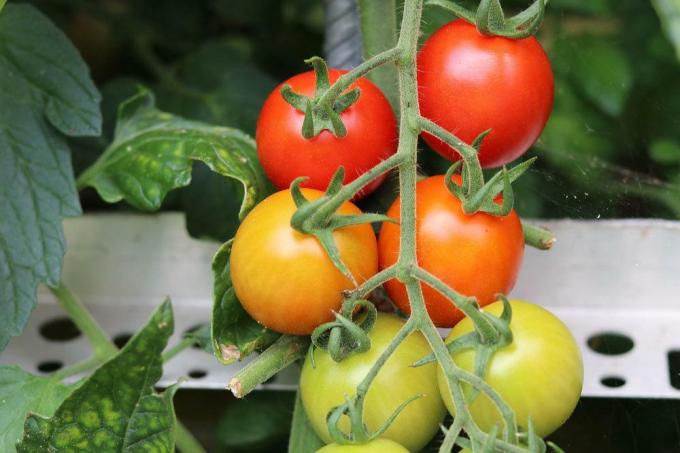
table of contents
- Tomatoes don't bloom
- causes
- Immediate action
- Change nutrient supply
- Change water supply
- Change location
- Start pest control
Tomato plants were grown with great effort and passion - and then they just don't bloom. Apart from the fact that it takes a lot of patience for tomatoes to bloom, it could be due to the wrong location or the wrong care. The only measures that will help in the short term are to change the conditions. So the causes have to be fought consistently so that the tomatoes may still bloom.
Tomatoes don't bloom
Solanum lycopersicum, the botanical name of the tomato, can sometimes be a real diva - a very bitchy one, mind you. This can be seen, among other things, in their flowering behavior. It cannot be said exactly when it should actually develop flowers. Rather, it depends on a whole series of factors that can influence the flowering time and later also the flowering time. This includes, for example, the weather, the location or the time at which the seeds were sown and released into the open. Anyone who is waiting for their tomato plants to bloom should therefore be very patient. If it takes a little longer, there is not always a problem. In general, it can be said: If the flower still fails to bloom in mid-June, then something is wrong.
tip: If you want to grow tomatoes, you should be careful right from the start that the site conditions and care are right. This is the only way to clarify whether there is really a problem if the flower does not bloom.
causes
As already mentioned, a lack of flowering in the vast majority of cases has to do with having done something wrong with the young tomato plants beforehand. Typical defects are:
- wrong location
- too much or too little poured
- poured over the leaves from above
- too much or too little fertilized
- Plants too little thinned
In some cases there can also be an infestation with Viruses or bacteria are present. Ultimately, animal pests can also be the cause of the problem. Solanum lycopersicum often struggles with the following pests:
- Spider mites
- Aphids
- Caterpillars
- Thrips
- Tomato minimizing moth
- white flies
In the event of a virus or bacterial attack, the plants can usually no longer be saved and you should immediately dispose of them in the household waste. Animal pests, on the other hand, can be combated. To do this, however, it is necessary to discover them as early as possible.
tip: You should regularly check tomato plants for pests from a very early stage. To do this, it is imperative to take a close look at the plant and, above all, to check the underside of the leaves.
Immediate action
Since tomatoes are relatively flexible in their flowering time, it is possible to get a plant to flower through short-term measures. To do this, the existing deficiencies simply have to be remedied as quickly as possible. The flowering and thus also the harvest will then shift backwards, but this is usually not a problem. The most important immediate measures that should be taken in the short term are:
Change nutrient supply
Too much or too little nutrients in the soil are the most common reasons tomatoes fail to flower. Therefore you have to check the fertilization once. There is something like a rule of thumb: In loamy, heavy soils, the plants need less nutrients than in soils that are sandy, well-drained and relatively dry. So the blooming remains on a sandy one Substrate simply give an additional dose of fertilizer. On loamy subsoil it only helps to wait until the nutrient potential has been used up.
tip: Nettle- Comfrey manure or comfrey manure are the ideal fertilizers to quickly stimulate flowering when there is a lack of nutrients on sandy soils.
Change water supply
Tomatoes need a lot of water in order to be able to develop the flowers first and then the fruits later. That is why you should definitely check the watering process and change it if necessary. The following applies: The soil around the root area should always be moist, but never soaking wet. It is also very important that you never water from above, but only directly in the area of the roots. The leaves of the plant must not get wet - neither from watering nor from rain. It may therefore be necessary to provide the plants with a roof if they are not positioned properly outdoors.
Change location
If the tomatoes don't bloom, the wrong location could be the trigger. Light is an essential factor for the development of the flowers. Without enough light, flowering will inevitably fail. It is therefore advisable to check the light supply and change it if possible. Often you don't even have to change location. The shoots that form between the stem and the base of the leaves often cause the plant to become very bushy. Large parts are then inevitably in the dark or are not supplied with sufficient light. Therefore, in such a case, the Intermediate shoots immediately and thoroughly removed. However, it is even better to continuously light the plant every now and then.
Start pest control
If you have discovered pests on the leaves or stems of the tomato plant, you must of course fight them immediately. A very effective and also very effective means is spraying with Nettle manurethat can be applied relatively easily. However, you should be very careful when spraying, because the leaves can hardly tolerate it when they get really wet. Alternatively, biological pest control agents can be used. However, chemicals should be avoided, after all, the tomato plants should not only bloom, but also fruit train that can be safely consumed.



